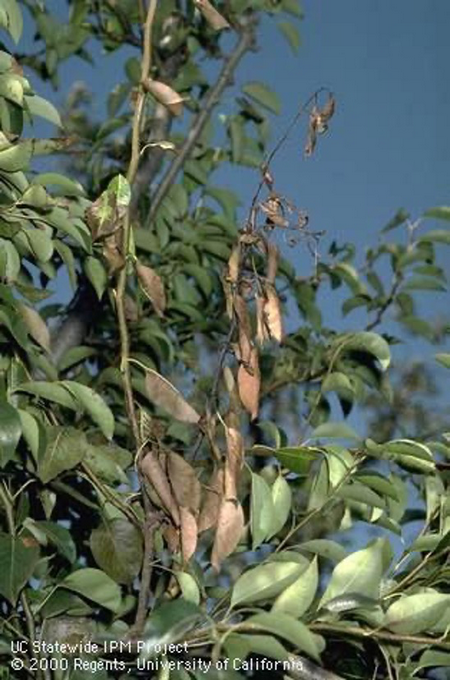Posts Tagged: fire blight
Lawn-pocalypse! Surviving Drought
Ah, summer! The season of sunburns, pool parties, and… lawn droughts. If your once lush, green carpet now looks like a crunchy brown doormat, you're not alone. Let's dive into why your yard is staging a dramatic death scene and what you can do to...

Bermuda grass and weeds overtaking drought stressed turf grass.
It’s Fire Blight Season!
If you are noticing droopy, dried-out flower clusters on your pears, Asian pears, quince, apples or crabapples, fire blight may be the cause. Fire blight is caused by a bacterium and is a common and frequently destructive disease that shows up in April...
Help! My Apple and Pear Trees are Burning Up!
Have you noticed burnt-looking blossoms and twigs on your apple, pear, or quince trees? This is likely caused by a bacterial infection, appropriately named fire blight. Fire blight can damage and even kill fruit trees in the Pome family and may affect other related species such as crabapple, ornamental pear, pyracantha, and toyon. It does not affect stone fruit, such as plum, peach, apricot, or cherries.
The disease is caused by a bacterium, Erwinia amylovora, which is most active during warm, wet spring weather. It enters the plant primarily through blossoms, but also through tender new shoots or bark wounded by mechanical injury or from strong hail and wind. It is spread by splashing water and pollinating insects, including bees. The pathogen is widespread in the environment but may not be much of a problem unless conditions are favorable. Older established trees can often withstand some fire blight damage, but young trees may be severely damaged.
The first sign of a fire blight infection may be dark and dried-up new shoots and young fruit, which soon turn black. You might also see watery, amber-colored droplets oozing from affected areas.
Fire blight may sometimes be confused with another condition, blossom blast, which also produces blackened flower clusters, but there are several symptoms characteristic of fire blight. On apples and pears, the tips of affected shoots develop a curved tip (‘Shepherd's Crook'). The scorched-looking young leaves and fruit do not fall off, but cling to the plant.
If a new fire blight infection is not removed in time, it spreads down through the wood, and bark cankers (areas of dead, discolored tissue) develop. If not removed, the infection in these areas persists from year to year.
Fire blight is not easy to control, but there are a few things you can do to manage this disease. Examine your trees regularly so you notice the first signs of a strike; the new shoots start to turn brown and droopy even before they become black. These shoots should be removed right away, cutting far enough below the infection to where no brown or discolored areas are seen. Use sharp pruners, disinfecting them between each cut. Use a 10% bleach solution or Lysol for disinfecting.
The disease becomes inactive during the summer and winter when bark cankers harboring the pathogen may be seen. These can be removed by pruning out diseased wood, at least 6–10 inches below the visible infection, or back to the branch connection with a larger branch or the trunk. If the canker is on a large limb or the trunk but does not girdle the branch, you can try scraping the bark away until no more discoloration is seen. Dispose of all infected material in the trash and not in the compost!
When fire blight is a problem from year to year, you can use a copper spray on the blossoms. This helps to prevent new infections but is not very effective if the pathogen is already in the tree. Such sprays can also cause russeting damage on the fruit.
When planting new trees, consider varieties that are more resistant to fire blight such as Arkansas Black or Cox's Orange Pippin. Unfortunately, many of our favorite varieties such as Pink Lady and Fuji, and most pears, are very susceptible. Tender new growth on a tree is more likely to suffer, so avoid practices that encourage this such as excess fertilizing and pruning. Also, don't irrigate while the tree is blooming.
This UC website provides more detailed information on fire blight and how to manage it.
https://ipm.ucanr.edu/PMG/PESTNOTES/pn7414.html
Help Desk of the UC Master Gardeners of Contra Costa County (SMW)
Climate-Change Resources
University of California UC ANR Green Blog (Climate Change and Other Topics) https://ucanr.edu/blogs/Green/index.cfm?tagname=climate%20change (full index)
Examples:
- Save Trees First: Tips to Keep Them Alive Under Drought https://ucanr.edu/b/~CdD
- Landscaping with Fire Exposure in Mind: https://ucanr.edu/b/~G4D
- Cities in California Inland Areas Must Make Street Tree Changes to adapt to Future Climate https://ucanr.edu/b/~oF7
Drought, Climate Change and California Water Management Ted Grantham, UC Cooperative Extension specialist (23 minutes) https://youtu.be/dlimj75Wn9Q
Climate Variability and Change: Trends and Impacts on CA Agriculture Tapan Pathak, UC Cooperative Extension specialist (24 minutes) https://youtu.be/bIHI0yqqQJc
California Institute for Water Resources (links to blogs, talks, podcasts, water experts, etc.) https://ciwr.ucanr.edu/California_Drought_Expertise/
UC ANR Wildfire Resources (publications, videos, etc.) https://ucanr.edu/News/For_the_media/Press_kits/Wildfire/ (main website)
-UC ANR Fire Resources and Information https://ucanr.edu/sites/fire/ (main website)
-Preparing Home Landscaping https://ucanr.edu/sites/fire/Prepare/Landscaping/
UC ANR Free Publications https://anrcatalog.ucanr.edu/ (main website)
- Benefits of Plants to Humans and Urban Ecosystems: https://anrcatalog.ucanr.edu/pdf/8726.pdf
-Keeping Plants Alive Under Drought and Water Restrictions (English version) https://anrcatalog.ucanr.edu/pdf/8553.pdf
(Spanish version) https://anrcatalog.ucanr.edu/pdf/8628.pdf
- Use of Graywater in Urban Landscapes https://anrcatalog.ucanr.edu/pdf/8536.pdf
- Sustainable Landscaping in California https://anrcatalog.ucanr.edu/pdf/8504.pdf
Other (Non-UC) Climate Change Resources
Urban Forests and Climate Change. Urban forests play an important role in climate change mitigation and adaptation. Active stewardship of a community's forestry assets can strengthen local resilience to climate change while creating more sustainable and desirable places to live. https://www.fs.usda.gov/ccrc/topics/urban-forests
Examining the Viability of Planting Trees to Mitigate Climate Change (plausible at the forest level) https://climate.nasa.gov/news/2927/examining-the-viability-of-planting-trees-to-help-mitigate-climate-change/
Reports and other information resources coordinated under the auspices of the United Nations and produced through the collaboration of thousands of international scientists to provide a clear and up to date view of the current state of scientific knowledge relevant to climate change. United Nations Climate Action
Scientific reports, programs, action movements and events related to climate change. National Center for Atmospheric Research (National Science Foundation)
Find useful reports, program information and other documents resulting from federally funded research and development into the behavior of the atmosphere and related physical, biological and social systems. Search and find climate data from prehistory through to an hour ago in the world's largest climate data archive. (Formerly the "Climatic Data Center") National Centers for Environmental Information (NOAA)
Think tank providing information, analysis, policy and solution development for addressing climate change and energy issues (formerly known as the: "Pew Center on Global Climate Change"). Center for Climate & Energy Solutions (C2ES)
Mapping Resilience: A Blueprint for Thriving in the Face of Climate Disaster. The Climate Adaptation Knowledge Exchange (CAKE) was launched in July 2010 and is managed by EcoAdapt, a non-profit with a singular mission: to create a robust future in the face of climate change by bringing together diverse players to reshape planning and management in response to rapid climate change. https://www.cakex.org/documents/mapping-resilience-blueprint-thriving-face-climate-disaster
Cal-Adapt provides a way to explore peer-reviewed data that portrays how climate change might affect California at the state and local level. We make this data available through downloads, visualizations, and the Cal-Adapt API for your research, outreach, and adaptation planning needs. Cal-Adapt is a collaboration between state agency funding programs, university and private sector researchers https://cal-adapt.org/
Find reports, maps, data and other resources produced through a confederation of the research arms of 13 Federal departments and agencies that carry out research and develop and maintain capabilities that support the Nation's response to global change. Global Change (U.S. Global Change Research Program)
The Pacific Institute is a global water think tank that combines science-based thought leadership with active outreach to influence local, national, and international efforts to develop sustainable water policies. https://pacinst.org/our-approach/
Making equity real in climate adaptation and community resilience policies and programs: a guidebook. https://greenlining.org/publications/2019/making-equity-real-in-climate-adaption-and-community-resilience-policies-and-programs-a-guidebook/
Quarterly CA Climate Updates and CA Drought Monitor Maps (updated each Thursday) https://www.drought.gov/documents/quarterly-climate-impacts-and-outlook-western-region-june-2022
Oh, No, Not Fire Blight!
If you are noticing droopy, dried-out flower clusters on your pears, Asian pears, quince, apples or crabapples, fire blight may be the cause. Fire blight is caused by a bacterium and is a common and frequently destructive disease that shows up in April...





